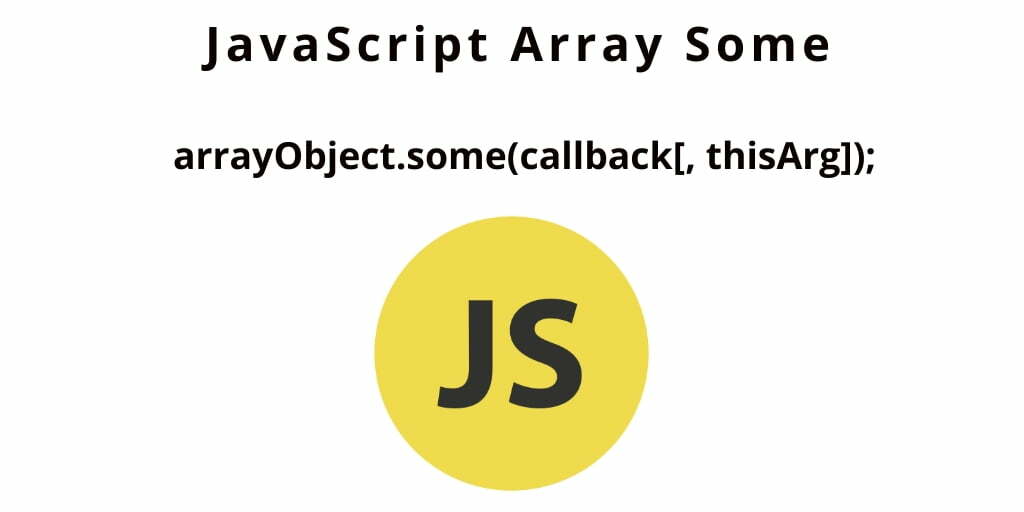JavaScript Array Some; In this tutorial, you will learn JavaScript Array some() method and how to use this method.
JavaScript Array some() method
When you work with javascript arrays and want to check if an array has at least one element that satisfies a specified condition.
See the following array in js:
let numbers = [ 1, 3, 5, 7, 10, 12, 15, 18 ];
Basically, you use a for loop and if statement for test a specified condition, like this:
let numbers = [ 1, 3, 5, 7, 10, 12, 15, 18 ];
let result = false;
for (let index = 0; index < numbers.length; index++) {
if (numbers[index] % 3 === 0 && numbers[index] % 5 === 0) {
result = true;
break;
}
}
console.log(result);
Output:
true
How it works:
- First of all, declare numeric array.
- Next, declare a flag variable
resultand assign value tofalse. - Iterate for loop over each element. And test specified conditions using if statement. If the condition met true, then assign the result to
trueand after that exit the loop using thebreakstatement. - Finally, print the result.
Instead of js for loop and if statement, you can use the some() method, test at least one element with the specified condition.
See the following example:
let numbers = [ 1, 3, 5, 7, 10, 12, 15, 18 ];
let result = numbers.some(function(e) {
return e % 3 === 0 && e % 5 === 0;
});
console.log(result);
Output
true
The condition is implemented via a js callback function passed in some () method.
Now, the js script is more concise and more readable way. So, you can use the arrow function syntax in ES6:
let numbers = [ 1, 3, 5, 7, 10, 12, 15, 18 ]; let result = numbers.some(e => e % 3 === 0 && e % 5 === 0); console.log(result);
Syntax JavaScript Array some()
The following represents the syntax of the some() method:
arrayObject.some(callback[, thisArg]);
The some() method accepts two parameters:
1) The callback parameters
The some() function executes the callback function once for each element in the array continuously it finds the one where the callback function returns a true. The some() method immediately returns true and doesn’t decide the remaining elements.
If no element causes the callback() to return true, the some() method returns false.
The callback function accepts 3 parameters:
function callback(currentElement [[, currentIndex], array]){ // ...}
- The
currentElementis the current element of an array. - The
currentIndexis the index of the current element. - The
arrayis array thatsome()was called upon.
2) The thisArg parameter
The thisArg parameter is optional. If you pass the thisArg into the method, you can use the thisArg as the this value inside the callback function.
Example: JavaScript Array some()
Let’s look at more examples of using the javascript some() method.
1) Check if an element exists in the array
Using theisExists() function to test if a passed element/value exists in an array, this function uses the some() method.
You can see the following:
function isExists(value, array) {
return array.some(e => e === value);
}
let numbers = [ 1, 3, 5, 7, 10, 12, 15, 18 ];
console.log(isExists(5, numbers));
console.log(isExists(15, numbers));
Output:
true false
2) Check if an array has one element that is in a range
Check if a given number between provided range in an array.
See the following example:
let marks = [4, 5, 7, 9, 10, 2];
const range = {
min: 8,
max: 10
};
let result = marks.some(function (e) {
return e >= this.min && e <= this.max;
}, range);
console.log(result);
Output:
true
Note that, If you call the javascript some() method on an empty array, the result is always false regardless of any condition.
See the following example:
let result = [].some(e => e > 0); console.log(result);
Output:
false
Conclusion
In this tutorial, you have learned how to use the JavaScript Array some() method to test if an array has at least one element that meets a condition.
